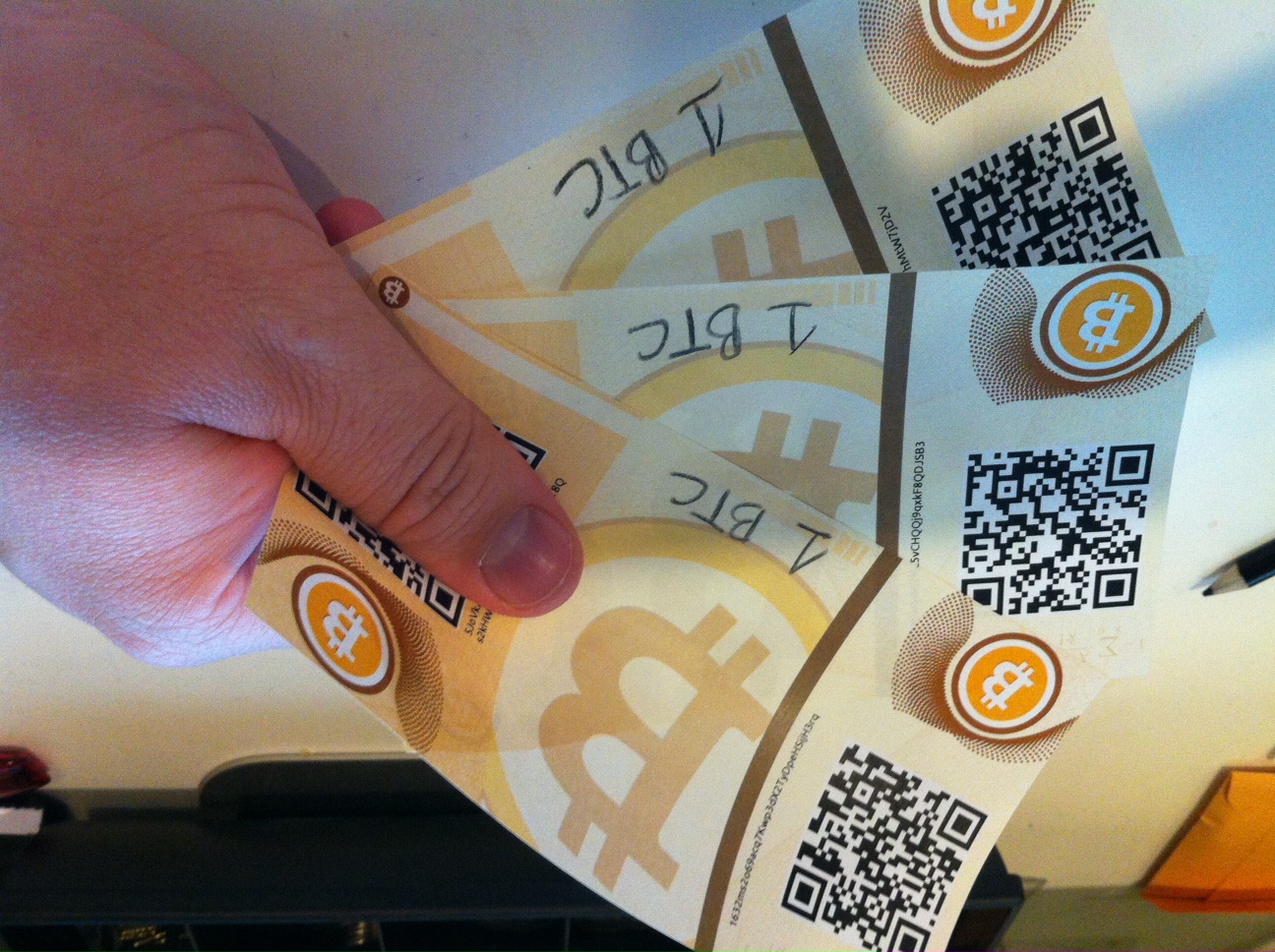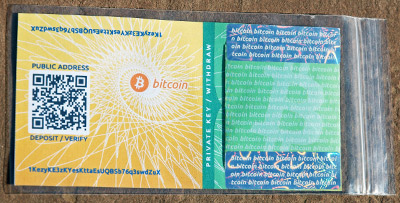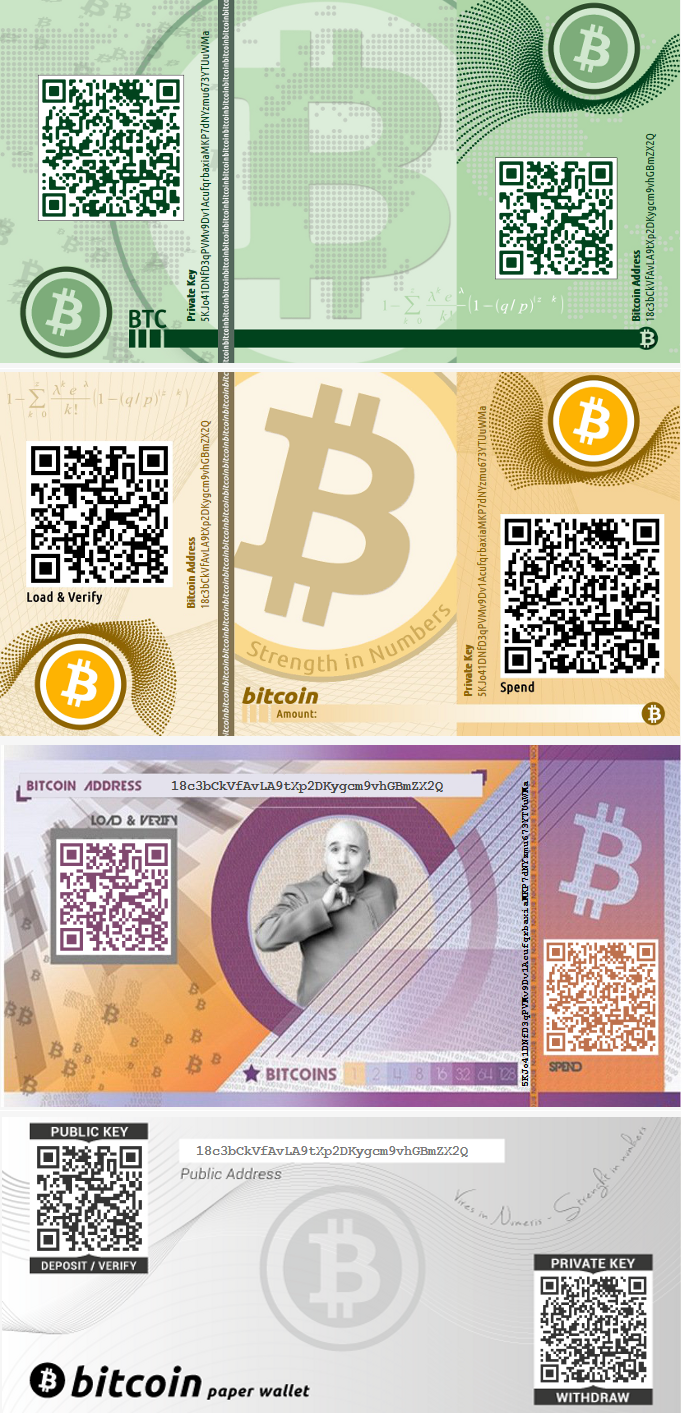Paper wallet: Difference between revisions
Expanded on why paper wallets are not a good idea, why they're not truly "wallets". Linked to HD backups as an alternative. Used term "paper wallet" throughout text since this is the consensus term. |
Remove link to key-generation website |
||
| Line 48: | Line 48: | ||
Care must be taken to securely generate keys since an attacker can steal stored bitcoins if it is exposed, transmitted, or generated with insufficient entropy. | Care must be taken to securely generate keys since an attacker can steal stored bitcoins if it is exposed, transmitted, or generated with insufficient entropy. | ||
Several tools exist for producing paper wallets, including [[Bitcoin Address Utility | Several tools exist for producing paper wallets, including [[Bitcoin Address Utility]], [[vanitygen]], and [[Cwallet]]. | ||
===Web-based key generators=== | ===Web-based key generators=== | ||
Revision as of 02:59, 1 March 2015

A paper wallet is a mechanism for storing bitcoins offline as a physical document that can be secured like cash or anything else of real-world value. It is only a wallet in the sense that it can store value. However, since a paper wallet only makes use of a single key and address pair, it should not be confused with a true hardware or software bitcoin wallet, which can facilitate the full spectrum of bitcoin transactions and multiple addresses.
In some cases, it may be preferable to produce Hierarchical Deterministic Wallet Backups, which can also be printed on paper and physically secured.
Paper wallets are generally created by printing a brand new private key onto paper, usually along with a bitcoin address derived from the key, and then sending bitcoins from a wallet to that address for safekeeping.
Storing bitcoins on paper wallets is not safe unless very strict security precautions are undertaken during their initial preparation. (See below.) Furthermore, paper wallets should not be reused for repeated deposits (as it reduces privacy) or for multiple withdrawals (as this may reduce the underlying cryptographic security at some point in the future.) Ideally, they should be used as "deposit once, sweep once" tools.
Use cases
Tips and gifts
By creating a keypair, one can store bitcoins on a physical medium to be left as a tip or a gift. The recipient then sweeps the private key to their own wallet.
Physical tokens
A trusted provider can hide the private key inside a tamper-resistant token, and issue them as a form of bitcoins. This requires those who accept it as payment to trust that when the provider produced the tokens, they loaded them with the correct amount of bitcoins, and that they have not been tampered with since then. To redeem the bitcoin value, the token must be destroyed to access the private key. Often a bitcoin address is embedded on the outside visible, but there is no guarantee (without destroying the token) that this matches the private key inside, or, even if it does, that the private key is not replicated on multiple tokens or saved by the producer.
As a wallet
Sometimes people try to use paper wallets as a true bitcoin wallet. However, a single paper wallet can only represent one bitcoin address. Because of this, one is forced to choose between hazardous options:
- Use the key only once to receive, and only once to send the full amount. This requires the user to know the full amount he wants to store in advance, and often leads to the next situation:
- Create multiple keys. By using more than one key, the user can receive more than once using a different address each time, including using new addresses for change. This is very complicated, and makes it easy to accidentally reuse addresses, produce the wrong change/fee combination, lose some keys, spend hours searching for the right key, etc. Not even skilled bitcoin experts are comfortable managing their own keys manually like this.
- Reuse the address. This has severe privacy and security implications. For more information, see the article on address reuse.
Since there is no safe way to use these for a wallet, it is generally considered inadvisable.
Key encoding/formatting


A paper wallet can be represented in several formats, but typically the Wallet Import Format (WIF) is used, since keys represented that way are very short (51 characters) and thus easy to re-enter when importing or "sweeping" it for withdrawal.
Creation of a paper wallet
Generation of secure keys
Care must be taken to securely generate keys since an attacker can steal stored bitcoins if it is exposed, transmitted, or generated with insufficient entropy.
Several tools exist for producing paper wallets, including Bitcoin Address Utility, vanitygen, and Cwallet.
Web-based key generators
Some websites feature free open-source client-side keypair generators written in JavaScript. Keypairs generated by JavaScript or using websites are generally considered inherently weak and insecure, and unless the code of the website is audited every time it is used, it may leak the keys to the server. Even with careful code auditing, browser plugins or other websites may compromise the environment.
Recommendations
- Keys should be produced on a computer not connected to the Internet.
- Be aware that malware often allows a remote third party to view your screen and see your keystrokes, and these can compromise the integrity of your key. Also consider that antivirus software cannot completely rule out the possibility of malware. However, booting from a live disc prevents most malware from running.
- The private keys should never be saved to a computer hard drive or sent via email or other network connections. You should also never scan/type your key into your computer, except at the moment you are redeeming it.
- If possible, the private key should be kept hidden, for example by using BIP38 encryption, and/or by folding the paper to hide the private key so that a photograph or photocopy of it will not reveal or replicate the private key.
- A web-based generator should not be used.
- A generator should use an appropriate source of random numbers (entropy). This means that the generated keys aren't predictable. If the addresses come from a predictable or partially-predictable patterns like pseudorandom numbers [1], someone else who can predict the pattern can steal the balance. Randomness should NEVER be human generated, as the human brain is incapable of secure entropy.
- Remember that unlike wallets, a single paper wallet is only good to receive a single payment, and must be redeemed in its entirety.
Printer Security
Some advanced printers have internal storage (even hard drives) that preserve copies of printouts. This is a risk if someone gets access to your printer, or if you dispose of your printer. There is also the possibility that a smart enough printer can be hacked. (Consider StuxNet which was able to rewrite the firmware of non-computer devices indirectly connected to the Internet) If this concerns you, use a "dumb" printer, and never let your printer have access to the Internet or to an Internet-connected computer.
Redeeming Keys and Withdrawing Funds
Paper wallets are very different from wallets such as Bitcoin Core in that it is not possible to transfer (withdraw) a portion of a key's bitcoins. The only way to withdraw funds is to import or "sweep" the entire received amount to a new address, typically a wallet or online exchange. Once the transfer has been confirmed, the key should not be reused.[2]
There are various methods for copying the private key data to other wallets.
- bitcoind supports an "importprivkey" RPC method for this purpose.
- Bitcoin-Qt's debug console can also be used in a similar way (see also How to import private keys in Bitcoin Core 0.7+).
- BlockChain.info and Armory can also import them directly into wallets.
Note that importing a private key that may be compromised can result in the entire wallet becoming insecure. For this reason, sweeping is generally recommended over importing.
References
- ↑ Pseudorandomness is not enough for strong cryptography
- ↑ reddit.com Using Paper Wallets and Understanding Change
See Also
- Blockchain.info tutorial on how to generate a paper wallet.